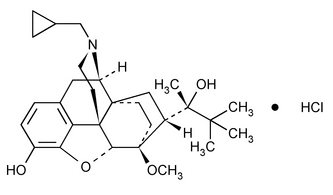Buprenorphine Hydrochloride
(bue'' pre nor' feen hye'' droe klor' ide).
6,14-Ethenomorphinan-7-methanol, 17-(cyclopropyl-methyl)-
21-Cyclopropyl-7
» Buprenorphine Hydrochloride contains not less than 98.5 percent and not more than 101.0 percent of C29H41NO4·HCl, calculated on the anhydrous basis.
Packaging and storage—
Preserve in tight, light-resistant containers.
Identification—
B:
To 0.5 mL of a solution of buprenorphine hydrochloride in methanol containing 50 mg per mL add 0.2 mL of a freshly prepared solution (1 in 10) of potassium ferricyanide TS and 0.5 mL of ferric chloride TS: a blue color appears immediately.
C:
A solution (1 in 100) meets the requirements of the tests for Chloride  191
191 .
.
pH  791
791 :
between 4.0 and 6.0 in a solution containing 10 mg per mL.
:
between 4.0 and 6.0 in a solution containing 10 mg per mL.
Water, Method I  921
921 :
not more than 1.0%.
:
not more than 1.0%.
Residue on ignition  281
281 :
not more than 0.1%.
:
not more than 0.1%.
Chromatographic purity—
Mobile phase—
Prepare a filtered and degassed mixture of methanol, 1% solution of ammonium acetate, and glacial acetic acid (60:10:0.01). Make adjustments if necessary (see System Suitability under Chromatography  621
621 ).
).
Standard solution—
Dissolve accurately weighed quantities of USP Buprenorphine Hydrochloride RS and USP Buprenorphine Related Compound A RS in Mobile phase to obtain a solution having a known concentration of 12.5 µg of each Reference Standard per mL.
Test solution—
Dissolve an accurately weighed quantity of about 50 mg of Buprenorphine Hydrochloride in 10.0 mL of Mobile phase to obtain a solution having a concentration of about 5 mg per mL.
Chromatographic system
(see Chromatography  621
621 )—The liquid chromatograph is equipped with a 288-nm detector and a 4.6-mm × 25-cm column containing packing L1. The flow rate is about 1 mL per minute. The column temperature is maintained at 40
)—The liquid chromatograph is equipped with a 288-nm detector and a 4.6-mm × 25-cm column containing packing L1. The flow rate is about 1 mL per minute. The column temperature is maintained at 40 . Chromatograph the Standard solution, and record the peak responses as directed for Procedure: the resolution, R, between buprenorphine hydrochloride and buprenorphine related compound A is not less than 3.0; the column efficiency is not less than 6500 theoretical plates; and the relative standard deviation for replicate injections is not more than 2.0%.
. Chromatograph the Standard solution, and record the peak responses as directed for Procedure: the resolution, R, between buprenorphine hydrochloride and buprenorphine related compound A is not less than 3.0; the column efficiency is not less than 6500 theoretical plates; and the relative standard deviation for replicate injections is not more than 2.0%.
Procedure—
Separately inject equal volumes (about 20 µL) of the Standard solution and the Test solution into the chromatograph, and allow the Test solution to elute for not less than two times the retention time of buprenorphine hydrochloride. Record the chromatograms, and measure the areas for the major peaks. Calculate the percentage of each impurity in the portion of Buprenorphine Hydrochloride taken by the formula:
100(ri / rS)(CS / CT)
in which ri is the peak response for each impurity obtained from the Test solution; rS is the peak response of buprenorphine hydrochloride obtained from the Standard solution; CS is the concentration, in mg per mL, of USP Buprenorphine Hydrochloride RS in the Standard solution; and CT is the concentration, in mg per mL, of Buprenorphine Hydrochloride in the Test solution: not more than 0.25% of any individual impurity is found, and the sum of all impurities is not more than 0.65%.
Assay—
Dissolve about 0.8 g of Buprenorphine Hydrochloride, accurately weighed, in 50 mL of glacial acetic acid, add 10 mL of mercuric acetate TS and 2 drops of crystal violet TS, and titrate with 0.1 N perchloric acid VS to a green endpoint. Perform a blank determination and make any necessary correction. Each mL of 0.1 N perchloric acid is equivalent to 50.41 mg of C29H41NO4·HCl.
Auxiliary Information—
Please check for your question in the FAQs before contacting USP.
| Topic/Question | Contact | Expert Committee |
|---|---|---|
| Monograph | Clydewyn M. Anthony, Ph.D.
Senior Scientific Liaison 1-301-816-8139 |
(SM22010) Monographs - Small Molecules 2 |
| Reference Standards | RS Technical Services 1-301-816-8129 rstech@usp.org |
USP35–NF30 Page 2402

